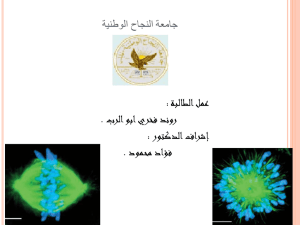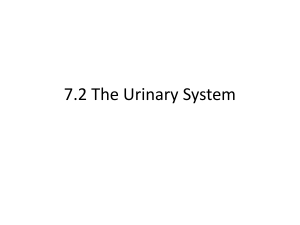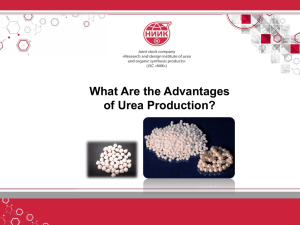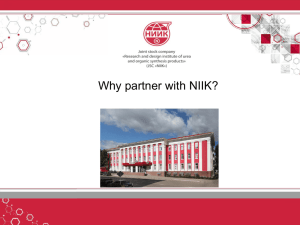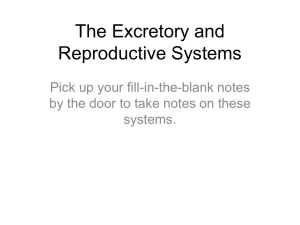Urea as an Energy Carrier
advertisement
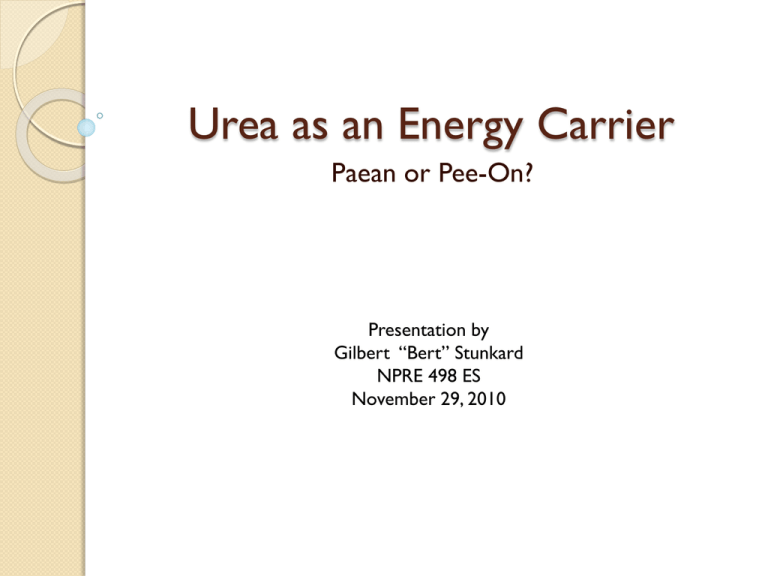
Urea as an Energy Carrier Paean or Pee-On? Presentation by Gilbert “Bert” Stunkard NPRE 498 ES November 29, 2010 Urea as an energy carrier Urea as a hydrogen carrier Direct Urea fuel-cell Urea Production/Manufacture Urea: Vision, Economics, Advantages, Disadvantages Direct Ammonia Fuel Cell Urea properties Source: en.wikipedia.org/wiki/urea1 Urea properties Source: en.wikipedia.org/wiki/urea Urea as a Hydrogen Carrier 0.33 M Urea, inexpensive Ni catalyst, electrochemical oxidation. Claim this is the first technology that directly converts urea to hydrogen. Bryan K. Boggs, Rebecca L. King, Gerardine G. Botte* ,“Urea electrolysis: direct hydrogen production from urine”, in Chem. Commun., 2009, 4859-4861. (Dept. of Chemical and Biomolecular Engineering, Ohio University, Athens OH)2 Urea as a Hydrogen Carrier CO2 is actually captured at potassium carbonate K2CO3. OH- provided as potassium hydroxide (KOH). Nitrogen at the anode, hydrogen at the cathode. Urea as a Hydrogen Carrier Explored Ni, Pt, Pt-Ir, Rh catalysts Nickel oxyhyrdoxide modified nickel electrodes (NOMH) electroplated on Ni foil, Ni gauze, Ti Foil, Ti gauze yield higher current densities than M/Ni (metallic substrate) electrodes Urea as a Hydrogen Carrier Nickel in hydroxide media converts to Ni(OH)2 (Ni2+) and NiOOH (Ni3+) Ionic nickel probably enhances electrochemical oxidation Absorption of urea on NiOOH surface likely rate limiting step. Urea as a Hydrogen Carrier Requires electric energy to release hydrogen 1.4 [v] achieved experimentally (0.37 [v] required theoretically) vs 2.0 [v] for hydrogen Experimentally requires 30 % less energy than electrolytic hydrogen (theoretically could use 70% less) Urea as a hydrogen carrier Research project was to remediate urea containing waste water from urea manufacture or to use urine or biomass produced urea as fuel Direct Urea Fuel Cell Rong Lan, Shanwen Tao*, and John T. S. Irvine, “A direct urea fuel cell – power from fertiliser and waste”, in Energy. Environ. Sci. 2010, 3, 438-441. (Herriot Watt University, Edinburgh. University of St. Andrews, Fife, UK).3 Again, claim first time achievement Direct Urea Fuel Cell Direct Urea Fuel Cell Theoretical open circuit voltage (OCV): 1.146 [v] at room temperature (H2/O2 fuel cell is 1.23 [v]). Theoretical maximum efficiency is 102.9% at room temperature (vs 83 % for H2). Positive entropy change of reaction 3. Absorbs heat from ambiance and converts to electricity. Direct Urea Fuel Cell – Technical Challenges Hydrolysis of urea produces ammonia. Reaction of urea with oxygen produces CO2. Not compatible with acidic Nafion membrane and other proton exchange membrane fuel cell (PEMFCs) mebranes. Direct Urea Fuel Cell – Technical Challenges Alkaline membranes based on ammonia quaternary salts are CO2 compatible and introduction of CO2 at cathode can improve performance, allowing use of wet air. Amberlite IRA 78 Hydroxide, a styrenedivinyl benzene resin (R)n~N+(CH3)3 OH Urea Fuel Cell – Tech Challenges Divinylbenzene crosslinks make a 3-D network resin Polystyrene graphic: http://en.wikipedia.org/wiki/Polystyrene Quaternary ammonium hydroxide groups added by presenter Direct Urea Fuel Cell – Technical Challenges AER: Membrane: Amberlite IRA78, hydroxide form, 60/40 with (poly vinyl alcohol) PVA MW 50,000. Current Collectors: Carbon papers (Toray 090, water proofed for anode, plain for cathode, E-TEK). Low cost catalyst like nickel, silver, MnO2 are stable in the alkaline membrane environment Direct Urea Fuel Cell – Two different anodes Pt/C (30 wt % , E-TEK 0.6 mg/cm2). Ni/C (Nano size nickel mixed with carbon 50/50 wt %, ~20 mg/cm2). Direct Urea Fuel Cell – Three different cathodes Pt/C (30 wt % , E-TEK 0.6 mg/cm2). Ag/C (Nano size silver mixed with carbon 50/50 wt %, ~20 mg/cm2). MnO2/C (Nano size MnO2 mixed with carbon 20 wt % MnO2, ~20 mg/cm2). Direct Urea Fuel Cell – Three grades urea ACS grade, various concentrations Commercial Ad-Blue (32.5 wt % urea) from a local garage. Human urine (source not revealed) Direct Urea Fuel Cell Ni/C – MnO2/C Fuel cell performance, room temperature (O2) Direct Urea Fuel Cell Ni/C – MnO2/C Fuel cell performance, 50o C, O2 Direct Urea Fuel Cell – Performance Issues Higher urea concentrations (3,5 M) decreased voltage. Urea molecules are large: high concentration may cause slow diffusion at the anode thus increasing polarization loss. Elevated temperature benefits all anode and cathode types. Direct Urea Fuel Cell – Performance Issues Ni/C Anode, MnO2 cathode: slightly higher voltage and power density than Ag/C cathode. At 50o C, Ni/C, MnO2 (using O2) cell outperformed all Pt/C cell at room temperature (using air). Direct Urea Fuel Cell – Performance of Ad-Blue AdBlue (32.5%, ~5 M) ironically had higher voltages and power densities than comparable urea solutions (0.3 mW/cm2 versus 0.2 mW/cm2) Dilute Ad-blue gave better performance than pure Ad-Blue. 10% Ad-Blue highest current and power densities Direct Urea Fuel Cell Research project was to remediate urea containing waste water from urea manufacture or to use urine or biomass produced urea as fuel Urea – Manufacture4 Basaroff reactions: NH2COONH4: ammonium carbamate Requires ammonia Ammonia requires hydrogen Urea – Manufacture4 Basaroff reactions: Step 2 is the dehydration of ammonium carbamate to urea at increased temperature and pressure Urea Manufacture4 Hydrogen plant, ammonia plant, urea plant usually integrated on a single site Hydrogen plant usually employs steam reformation of methane Carbon dioxide goes to urea plant Hydrogen goes to ammonia plant, where nitrogen and hydrogen are reacted over iron catalysts (Haber process) Urea Manufacture4 Integrated plant optimizes energy transfer and waste recycle Incomplete utilization of ammonia and carbon dioxide on each pass requires stripping of product from reactants and recycle of reactants Wastewater is high in urea (~2%), chemical hydrolysis returns ammonia and carbon dioxide to reactor Urea – Manufacture4 Urea – Manufacture4 Carbamate solution is corrosive (carbamate is an electrolyte) Urea is not corrosive Heat exchange critical to process efficiency Carbamate solutions are most destructive to heat exchangers Urea Vision Urea less toxic than ammonia or methanol Urea less combustible, less explosive than hydrogen, ammonia, or methanol Urea easier to transport than anhydrous ammonia or hydrogen Urea Vision Green hydrogen + waste carbon dioxide = urea Initiate distribution via existing agricultural and Ad-blue© suppliers Ad-Blue: a 32.5% solution of urea and deionized water used for nitrogen oxides removal from diesel exhaust5 Urea Vision5 Source: BP/Dureal “Guide to Ad-Blue”, 2010 Urea Vision Agricultural urea granules are treated with formaldehyde4 Urea prills have problems with dust and moisture absorption4 Ad-Blue freezes at -11o C (12o F)5 Urea solutions slowly decompose to ammonia and isocyanuric acid.4 Urea: Energy density comparison Urea – Cost Comparison Substance Pricet ( ¢/kg) Methanol Liquid NH3 Urea 44.5 45.0 38.0 Gravimetric Energy Density* (MJ/kg) 22.66 22.48 10.536 Energy Cost (¢/MJ) 1.96 2.00 3.61 Gravimetric Energy Density (kW.hr/kg) 6.278 6.244 2.9267 October prices from www.icis.com, prices at plant *Calculated from heats of combustion found in CRC Handbook Online t Energy Cost (¢/kW.hr) 7.07 7.21 13.0 Urea Economics Conversion of natural gas to urea => 55% energy efficiency. 3 Efficiency of fuel cell yet to be determined, optimized, or perfected With 50% fuel-cell efficiency, overall efficiency would be ~25%. Comparable to LNG fired internal combustion engine. Urea Economics Urea must become comparable in price (based on MJ/kg) to methanol or ammonia. Urea fuel-cell efficiency would need to exceed methanol or ammonia fuel cell efficiency Otherwise confined to niches where flammability of methanol or toxicity of ammonia present problems. Ammonia as energy carrier No need to make urea CO2 can be sequestered at hydrogen plant Carbon neutral: green hydrogen + atmospheric nitrogen = ammonia Ammonia fuel cells have head start. First direct ammonia fuel cell was 1969.6 Potential to make ammonia electrolytically from just water and nitrogen. Ammonia Fuel Cell Rong Lan and Shanwen Tao*, “Direct Ammonia Alkaline Anion-Exchange Membrane Fuel Cells”, in Electrochemical and Solid-State . Letters, 13(8) B83-B86 (2010). Heriot-Watt University, Edingburgh, UK, Department of Chemistry 6 Ammonia Fuel Cell Ammonia Fuel Cell - Membrane Membrane: Chloroacetyl poly(2,6dimethyl-1,4-phenylene oxide) (CPPO) blended 50/50 with Polyvinyl alcohol (PVA) 50K M.W. for strength. S Structures: SCIFINDER/CAS Chemical Substance Registry, RN 24938-67-8, RN 79-04-8 Ammonia Fuel Cell - Electrodes Anode: Cr-decorated Ni (CDN) molar ratio 97.7:2.3 Ni/Cr. 50/50 wt % CDN/Carbon, 10 mg/cm2. Cathode: MnO2/C (20 wt % MnO2) cathode, 20 mg/cm2. Also tested PtRu/C anode with Amberlite IRA400/PVA membrane Ammonia Fuel Cell Reference: 6 Ammonia Fuel Cell Claim maximum power density of 16 mW/cm2 with CPPO membrane at voltage of ~0.85 [v] using pure oxygen.6 (Some conflict with plot in previous slide). 1.17 [v] is theoretical maximum Urea as hydrogen carrier2 Hydrogen carrier – requires electricity to free hydrogen from urea Experimental cell only uses 30 % less energy than freeing hydrogen from water Theoretically limited to 70% less energy than freeing hydrogen from water Process development is for remediation of urea production wastewater or urine as fuel Urea Fuel Cell Urea less toxic than ammonia, less flammable than methanol Urea likely more expensive fuel than ammonia or methanol Urea is not carbon neutral Urea requires ammonia to make, ammonia requires hydrogen Further research Urea fuel cell improvement for use with urea waste or biomass derived urea Ammonia more promising than urea as energy carrier Ammonia fuel cell improvement Possible electrolytic production of ammonia from water and atmospheric nitrogen References (1) “Urea”, http://en.wikipedia.org/wiki/Urea (2) Bryan K. Boggs, Rebecca L. King, Gerardine G. Botte* ,“Urea electrolysis: direct hydrogen production from urine”, in Chem. Commun., 2009, 4859-4861. (Dept. of Chemical and Biomolecular Engineering, Ohio University, Athens OH) (3) Rong Lan, Shanwen Tao*, and John T. S. Irvine, “A direct urea fuel cell – power from fertiliser and waste”, in Energy. Environ. Sci. 2010, 3, 438441. (Herriot Watt University, Edinburgh. University of St. Andrews, Fife, UK). References (4) Josef H. Meesen, “Urea”, in Ullman’s Encyclopedia of Industrial Chemistry, 2010, Wiley-VCH Verlag & Co. KGaA, Weinheim, 10.1002/ 14356007.a27_333.pub2. (5) BP and Dureal “Ab-Blue Handbook”, 2010 (6) Rong Lan and Shanwen Tao*, “Direct Ammonia Alkaline Anion-Exchange Membrane Fuel Cells”, in Electrochemical and Solid-State Letters, 13(8) B83-B86 (2010). Heriot-Watt University, Edingburgh, UK, Department of Chemistry. Additional references Hazel Muir, “Pee Power”, in New Scientist, 207(2774), 21 August, 2010, 27-39. Dr. Carl Feickert, “Hydrogen production from waste stream urea recover”, ERDCCERL, Champaign, IL Branch. George Marnellos and Michael Stoukides, “Ammonia synthesis at atmospheric pressure”, in Science, 282, 1998, 98-100. Covers electrolytic ammonia preparation at atmospheric pressure and room temperature via hydrogen and nitrogen.

